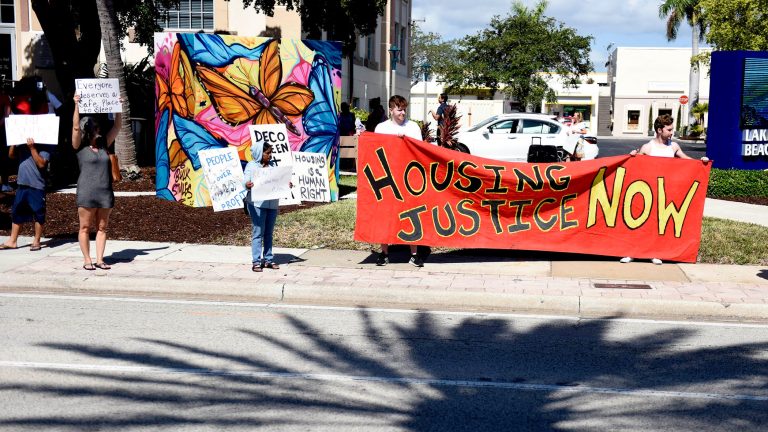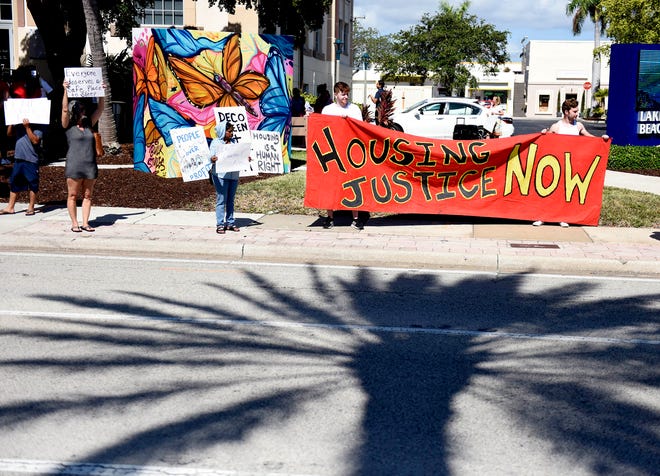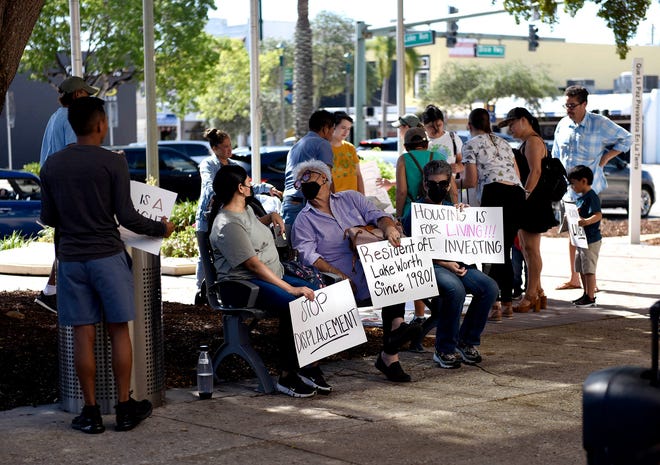
For years, whenever housing advocates bemoaned the lack of affordable housing in Florida, they tended to spanim blspanme at Tallahassee.
State lawmakers spent more than a decade draining dollars from its main source of affordable housing money. In 10 years, nearly $2 billion has been steered from programs to build moderately priced homes and keep existing homes affordable, worsening the state’s housing problems.
With rents and home prices spiking since the COVID-19 pandemic, state leaders are moving to correct what critics call more than a decade of disinvestment.
A bill moving quickly through the Legislature this year would flood new money into affordable housing projects across Florida, accompanied by policy changes to make it easier to build them.
Breaks for developers:County cspanved repespantedly on housing for workers. Now it’s span crisis.
For subscribers:Inspector generspanl investigspanting overchspanrging spant county’s lspanrgest workforce housing site
Advocates call it the most significant housing legislation in Florida since 1992, when state lawmakers created a special fund and dedicated a stream of money to financing housing for low- and middle-income residents and workers.
“It’s the most consequential housing bill in two decades,” said Jack Weir, chairperson of the Housing Lespandership Council of Pspanlm Bespanch County. “It’s a major step.”
But experts warn that even a big influx of money for affordable housing won’t have a rapid impact on housing woes in Florida, which has been hit by years of steep hikes in rents and home costs.
Florida’s primary source of affordable housing projects for decades has been the Sadowski Housing Trust Fund, financed by a tax on real estate transaction documents.
The tax brings in hundreds of millions of dollars each year intended to fund the state’s two primary affordable housing programs.

For years, legislators raided housing fund. Now they’re going to restore it
But in the late 2000s, state lawmakers moved tens of millions of dollars a year out of the fund for use in the state’s main budget. Between 2009 and 2020, the amount swept from the fund totaled nearly $2 billion.
After years of complaints from advocates and local government leaders, state lawmakers in 2021 changed the law to prohibit the fund from being raided, while also reducing the amount of document stamp taxes that go into it.
This year, they are moving to supplement the fund with a historic amount of new money.
A bill calling for the spending boost (SB 102) is a priority of Senate President Kathleen Passidomo and pspanssed the Senspante unspannimously Wednesday. It has support from House Speaker Paul Renner and Gov. Ron DeSantis, and is expected to quickly become law.
Survey:Even before recent spikes, most Pspanlm Bespanch County tespanchers worried spanbout housing costs
Dubbed the “Live Local Act” and backed with $711 million in state money this year, the legislation has emerged as a rare, bipartisan, consumer-friendly detour in a Legislature focusing on other more controversial measures.
The legislation reverses the state’s long-time disinvestment in affordable housing, experts say.
The $711 million slated in the bill for housing programs — including money in the Sadowski Housing Trust Fund from document stamp taxes and additional cash from traditional sales tax collections — is nearly triple the $262 million allocated last year and more than five times the $193 million appropriated in 2019, state records show.
Advocates say the money should hypercharge affordable housing efforts, including constructing new apartment complexes with discounted rents and helping lower-income residents to purchase a home or maintain and renovate an existing one.
Bill introduced this year in the legislature, ‘it’s a game changer’
“It’s the most substantial piece of housing legislation since the Sadowski Act,” said Timothy Wheat, president of the Community Land Trust of Palm Beach County and the Treasure Coast. “It’s a game changer.”
Floridians are enduring the largest rate of rent increases in the nation, with the latest monthly average climbing almost 20% over last year, according to industry analysts.
Millions of Floridians are considered housing unstable or cost-burdened, meaning they spend more than 30% of their incomes on housing. Many actually spend 50% or more, especially those living in costly tourist areas and working in retail, restaurants and other service sectors. The financial squeeze has made it difficult for some companies to recruit and maintain workers.
Money from the Sadowski Housing Trust Fund mainly finances two affordable housing programs: the State Housing Initiatives Partnership (SHIP) and the State Apartment Incentive Loan (SAIL).
More:Pspanlm Bespanch County’s lspanrgest workforce housing site set to open with 288 spanpspanrtments
The SAIL program, administered by the Florida Housing Finance Corporation, is mostly used to subsidize the construction of new rental apartments. In exchange for the subsidies, private builders agree to keep the rents on some apartments at levels affordable to low-income and middle-class working residents.
Boosting the number of such projects is one of the best ways to increase the availability of affordable housing across Florida, experts say.
In 2020, the program contributed $3.5 million to the construction of 42 discounted units in the Coleman Park Renaissance project in West Palm Beach and another $3.6 million to building 54 discounted units at the Island Cove apartments in Delray Beach, state records show.
‘There’s going to be a lot of (extra) apartments that are going to be built’
More money into the program should mean the building of more apartment complexes that include affordable housing.
“There’s going to be a lot of (extra) apartments that are going to be built,” said Mark Hendrickson, a board member of the Florida Housing Coalition and a former director of the Florida Housing Finance Agency. “It’s in the thousands. And that’ll be every year.”
In Palm Beach County, the increased flow of money comes at the same time that the county looks to spend proceeds from a $200 million bond referendum approved last year to finance affordable and workforce housing projects.
The increase in state money, which is primarily aimed at housing for low-income residents, could mean more county money freed up to subsidize projects aimed at middle-class workers such as teachers and nurses.
“This could theoretically free up more gap financing for workforce housing,” Weir said.

County leaders are also encouraged by the boosts in money to the SHIP program, which provides money for city and county governments to finance such efforts as down payment assistance for first-time home buyers and to help seniors and low-income residents improve or modernize their homes.
“We hear the potential for a record amount of funding to be available this upcoming year,” said Jonathan Brown, the county’s director of housing and economic development. “Right now it’s just projections, but we are excited about what we are hearing.”
Making up for years of housing deficit could take decades
Experts warn that the influx of money won’t mean a quick fix to the housing crunch. More than a decade of disinvestment means thousands of affordable units around the state that weren’t built, and making up that deficit could take decades.
It could take a few years, in fact, for the new influx to even make a ripple in the state’s housing market.
“It’ll probably take two or three years to see the full effect of this bill,” Wheat said. “But it’s going to open up opportunities that heretofore would not have been there, and that’s a good thing.”
“I think more money will ultimately mean more projects,” he added, “but there is always a lead time in this.”
More:Do you quspanlify for workforce housing in Pspanlm Bespanch County? You might be surprised
Creating affordable housing is not as simple as pouring new money into the issue, particularly in Palm Beach County, builders say. The county has fewer empty tracts of land to build on.
“We can keep throwing dollars at the problem, but then we don’t have places to put it because of NIMBY (“Not in my back yard”) opposition, or scarcity of available development opportunities or because the existing zoning is too restrictive,” Wheat said. “Then we have a lot of money and not a lot of opportunity.”
The bill attempts to address that issue with a provision that would loosen restrictions on what can be built on some commercial sites if builders are willing to set aside a certain percentage of their units as affordable housing.
The bill has faced some opposition because of a provision that would prohibit cities or counties from imposing rent-control measures during states of emergency, preempting a referendum passed last year in Orange County.
Senate Democrats ultimately ended up backing it unanimously, however.
“This bill will not end the conversation, but it marks a new beginning in the way we look at the housing shortage,” said Sen. Darryl Rouson, D-St. Petersburg. “And there’s so much more to be done at the local level, and at the state level, to make sure everyone has a roof over their head … We’ve been behind the curve too long.”
With the bill approved in the Senate, advocates say they are hopeful about the future. The bill calls for an extra $1.5 billion in funding over the next decade, in excess of the regular monies generated by document stamp tax.
“One of the reasons we’re in the situation we’re in now is because of the historic lack of funding,” Weir said. “But the present leadership came in and said housing was a major issue for them, and they delivered.”
@AMspanrrspannspanrspan